Which of the following observations and inferences led Charles Darwin to his theory of natural selection as a mechanism for evolution?
- Individuals with heritable traits best suited to the local environment will generally produce a disproportionate number of healthy, fertile offspring.
- Darwin synthesized his theory of natural selection from all of the listed observations and inferences.
- A population of any species has the potential to produce far more offspring than will survive to produce offspring of their own.
- Individuals of a population are unequal in the likelihood of surviving and reproducing.
Darwin synthesized his theory of natural selection from all of the listed observations and inferences.
Ex.
Darwin synthesized his theory of natural selection from all of the listed observations and inferences.
Individuals in a population of any species vary in many heritable traits. Individuals with heritable traits best suited to the local environment will generally produce a disproportionate number of healthy, fertile offspring. A population of any species has the potential to produce far more offspring than will survive to produce offspring of their own. Individuals of a population are unequal in the likelihood of surviving and reproducing.
The information in a gene that directs the production of a cellular product is gene expression. The correct sequence for the transfer of information from a gene to a function protein is __________.
- protein folding, transcription, and translation
- transcription, translation, and protein folding
- translation, transcription, and protein folding
- protein folding, translation, and transcription
- mRNA to DNA to protein
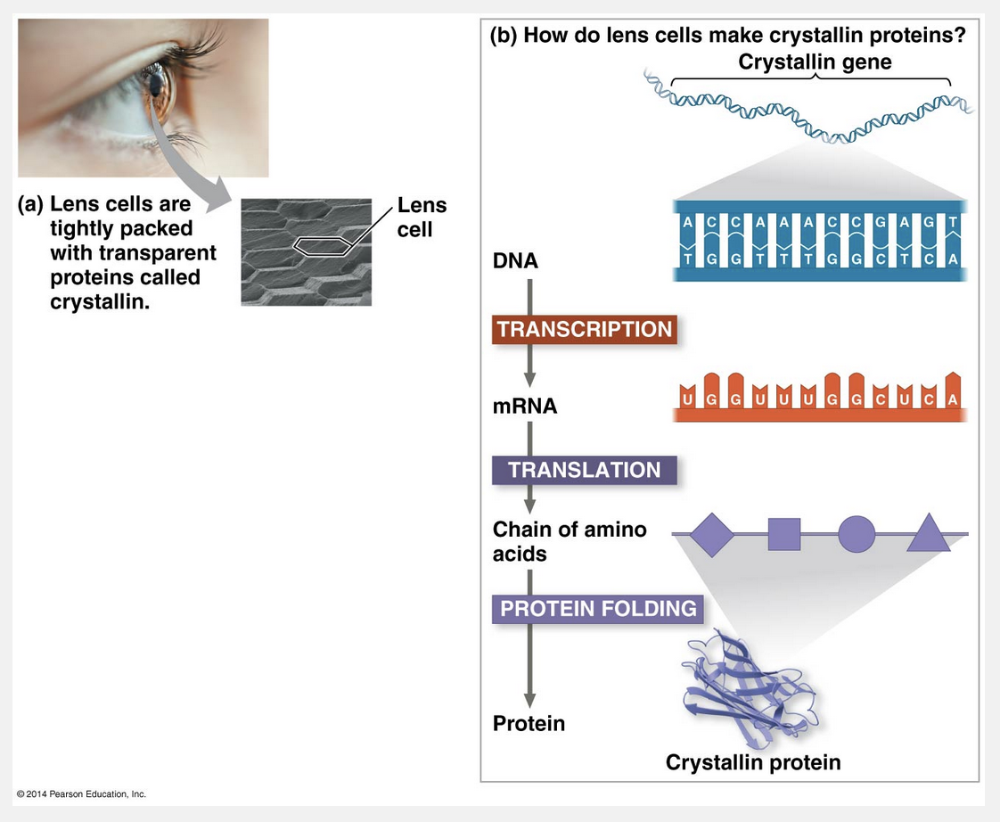
transcription, translation, and protein folding
Ex.
The information in a gene that directs the production of a cellular product is gene expression. The correct sequence for the transfer of information from a gene to a function protein is transcription, translation, and protein folding.
Many genes provide the blueprints for making proteins, which are the major players in building and maintaining a cell and carrying out its activities. For instance, a given bacterial gene may specify a particular protein (an enzyme) required to break down a certain sugar molecule, while a human gene may denote a different protein (an antibody) that helps fight off infection. Genes control protein production indirectly, using a related molecule called RNA as an intermediary. The sequence of nucleotides along a gene is transcribed into RNA, which is then translated into a linked series of protein building blocks called amino acids. These two stages result in a specific protein with a unique shape and function. The entire process, by which the information in a gene directs the manufacture of a cellular product, is called gene expression.
“Translation, transcription, and protein folding”; “protein folding, translation, and transcription”; and “protein folding, transcription, and translation” are incorrect because the first step in gene expression is the production of a mRNA molecule from the DNA gene in a process called transcription. “mRNA to DNA to protein” is incorrect because the correct sequence is DNA to mRNA to protein.
The best method for determining whether bean plants require sodium is to __________.
- measure the amount of sodium in a few bean plants
- measure how fast radioactive sodium enters the plant
- analyze root contents for sodium
- look for sodium in leaf tissues using autoradiography
- grow bean plants with and without sodium
grow bean plants with and without sodium
Ex.
The best method for determining whether bean plants require sodium is to grow bean plants with and without sodium.
In hypothesis-based scientific inquiry, an experiment must have an experimental group and a control group. In this case, growing bean plants with sodium would constitute the experimental group, and growing bean plants without the addition of sodium would constitute the control group.
None of the other answer choices listed present both a control group and an experimental group; thus, they are incorrect.
The two main forms of cells are __________ cells.
- plant and animal
- DNA and RNA
- None of the listed responses is correct.
- photosynthetic and nonphotosynthetic
- prokaryotic and eukaryotic
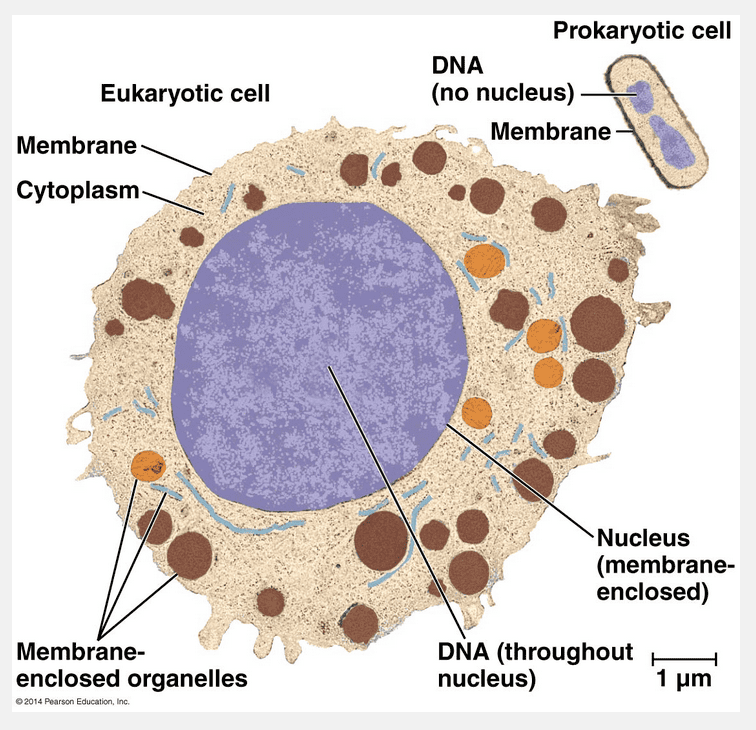
prokaryotic and eukaryotic
Ex.
The two main forms of cells are prokaryotic and eukaryotic cells.
All cells share certain characteristics. For instance, every cell is enclosed by a membrane that regulates the passage of materials between the cell and its surroundings. Nevertheless, we recognize two main forms of cells: prokaryotic and eukaryotic. The cells of two groups of single-celled microorganisms—bacteria (singular, bacterium) and archaea (singular, archaean)—are prokaryotic. All other forms of life, including plants and animals, are composed of eukaryotic cells.
“Plant and animal” is not correct because plants and animals are composed of eukaryotic cells, which is just one of the two main forms of cells.
“Photosynthetic and nonphotosynthetic” is not correct because these are processes and are not the two main forms of cells.
“DNA and RNA” is not correct because DNA is genetic material and RNA is an intermediary molecule that is used for the production of proteins.
The genetic material within cells is called __________ and is organized into structures called __________.
- None of the listed responses is correct.
- genes; DNA
- genes; chromosomes
- chromosomes; DNA
- DNA; chromosomes
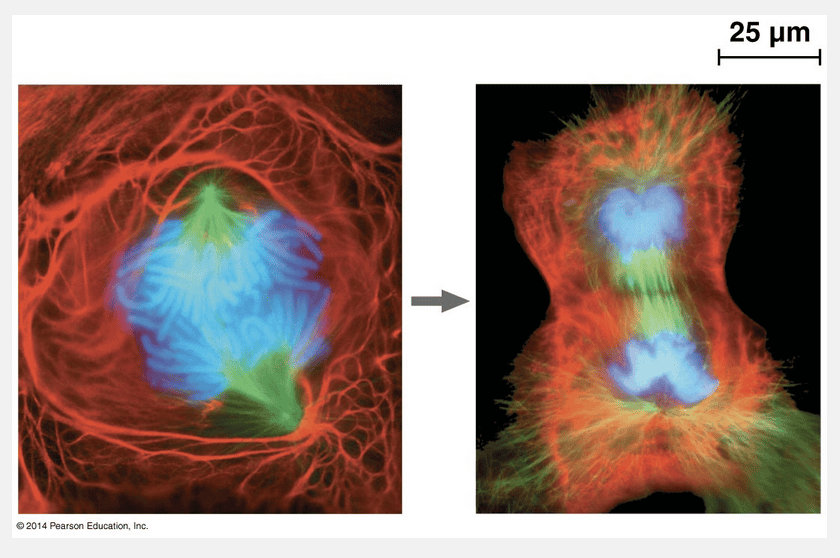
DNA; chromosomes
Ex.
The genetic material within cells is called DNA and is organized into structures called chromosomes.
Within cells, structures called chromosomes contain genetic material in the form of DNA (deoxyribonucleic acid). In cells that are preparing to divide, the chromosomes may be made visible using a dye that appears blue when bound to the DNA. Each chromosome contains one very long DNA molecule with hundreds or thousands of genes, each a section of the DNA of the chromosome.
“Chromosomes; DNA,” “genes; DNA,” and “genes; chromosomes” are incorrect because the genetic material is called DNA, and it is organized into structures called chromosomes. Genes are sections of the DNA on the chromosome.
How is the information encoded in DNA actually used by organisms?
- DNA is translated into protein and then transcribed to RNA.
- Proteins are built directly from the information in the DNA.
- DNA leaves the nucleus and interacts directly with other molecules in the cytoplasm.
- The information in DNA is transcribed to RNA and then translated into protein.
The information in DNA is transcribed to RNA and then translated into protein.
Ex.
The information in DNA is transcribed to RNA and then translated into protein.
The information encoded in DNA is first transcribed to RNA and then used to direct the synthesis of a protein, a process called translation.
It is not correct to say that proteins are built directly from the information in DNA or that DNA is translated into protein and then transcribed into RNA. DNA is always transcribed into RNA, and then the RNA code is translated into a specific protein with a unique shape and function. It is also incorrect to say that DNA leaves the nucleus and interacts directly with molecules outside the nucleus; DNA remains in the nucleus (of eukaryotic cells).
In the theme of biological organization, the approach called reductionism __________.
- starts at the global scale for studying biology
- is never used in the study of biology
- None of the listed responses is correct.
- allows us to reduce complex systems to simpler components that are more manageable to study
- focuses on information that is seen from space
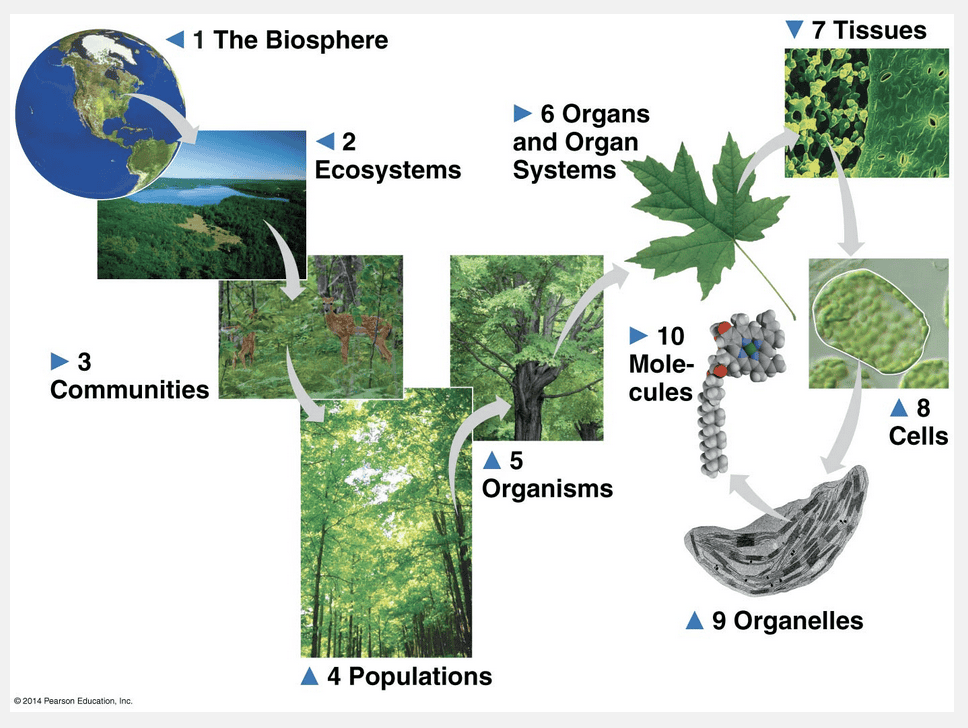
allows us to reduce complex systems to simpler components that are more manageable to study
Ex.
In the theme of biological organization, the approach called reductionism allows us to reduce complex systems to simpler components that are more manageable to study.
The study of life extends from the global scale of the entire living planet to the microscopic scale of cells and molecules. The numbers in the figure below guide you through the hierarchy of biological organization. Zooming in at ever-finer resolutions illustrates an approach called reductionism, which reduces complex systems to simpler components that are more manageable to study. Reductionism is a powerful strategy in biology.
“Starts at the global scale for studying biology” is incorrect because reductionism reduces complex systems to simpler components that are more manageable to study.
“Focuses on information that is seen from space” is incorrect because reductionism reduces complex systems to simpler components that are more manageable to study.
“Is never used in the study of biology” is incorrect because reductionism reduces complex systems to simpler components that are more manageable to study and is a powerful strategy in biology.
Using models that represented camouflaged and non-camouflaged mice, Hoekstra and her students tested the hypothesis that coloration of beach and inland mice provides camouflage that protects them from predation.
Regardless of whether the models were placed in the beach or the inland habitat, the camouflaged model always acted as the __________ group.
- experimental
- hypothetical
- None of the listed responses is correct.
- control
- dependent variable
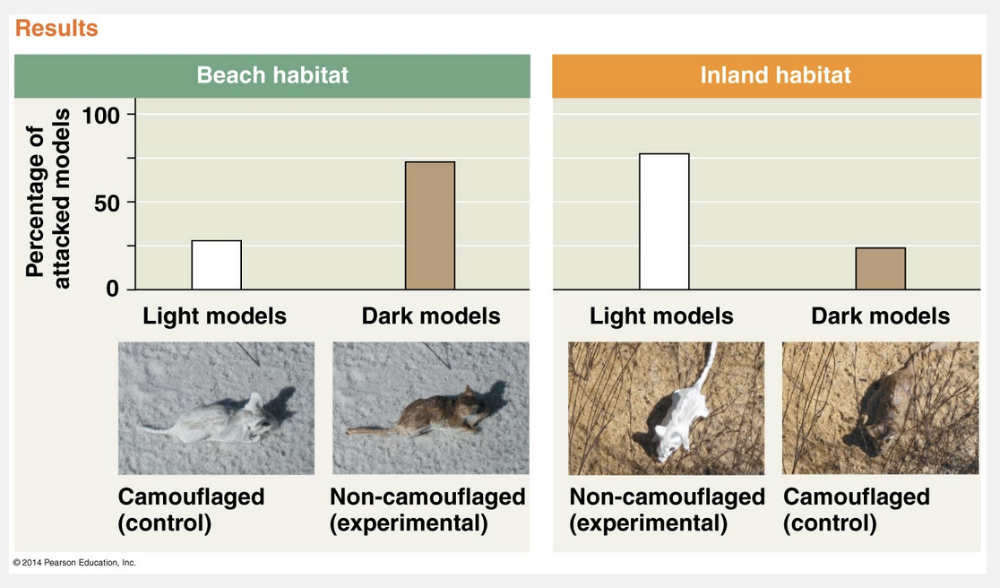
control
Ex.
Using models that represented camouflaged and non-camouflaged mice, Hoekstra and her students tested the hypothesis that coloration of beach and inland mice provides camouflage that protects them from predation. Regardless of whether the model was placed in the beach or the inland habitat, the camouflaged model always acted as the control group.
The researchers built hundreds of plasticine models of mice and spray painted them to resemble either beach mice (light colored) or inland mice (darker colored) so that the models differed only in their color patterns. The researchers placed equal numbers of these model mice randomly in both habitats and left them overnight. The mouse models resembling the native mice in the habitat were the control group (for instance, light-colored beach mouse models in the beach habitat), while the mouse models with the non-native coloration were the experimental group (for example, darker-colored inland mouse models in the beach habitat).
The following morning, the team counted and recorded signs of predation events, which ranged from bites and gouge marks on some models to the outright disappearance of others. Judging by the shape of the predator’s bites and the tracks surrounding the experimental sites, the predators appeared to be split fairly evenly between mammals (such as foxes and coyotes) and birds (such as owls, herons, and hawks). For each environment, the researchers then calculated the percentage of predation events that targeted camouflaged mouse models. The results were clear: Camouflaged models experienced much less predation than those lacking camouflage in both the beach habitat (where light mice were less vulnerable) and the inland habitat (where dark mice were less vulnerable).
“Experimental” and “dependent variable” are both incorrect because these variables are measured in the experiment. “Hypothetical” is incorrect because the camouflaged model always had the color pattern that resembled the mice in the habitat that was being studied.
A hypothesis must be testable and falsifiable to be scientifically valid. Being testable and falsifiable means that __________.
- the hypothesis has been proved wrong
- only a controlled experiment can prove whether the hypothesis is correct or incorrect
- there must be several options in the hypothesis to choose from, one of which is correct
- if the hypothesis is not correct, the experiment was a failure
- some conceivable observation or experiment could reveal whether a given hypothesis is incorrect
some conceivable observation or experiment could reveal whether a given hypothesis is incorrect
Ex.
A hypothesis must be testable and falsifiable to be scientifically valid. Being testable and falsifiable means that some conceivable observation or experiment could reveal whether a given hypothesis is incorrect. Hypotheses should be developed in a way that enables scientists to make predictions that can be tested and falsified by experiments or observations.
It is incorrect to say that only a controlled experiment can prove whether the hypothesis is correct or incorrect, although controls are required for a valid experiment. Being testable and falsifiable does not mean that the hypothesis has been proved wrong; thus, this answer is incorrect. Testing never “proves” that a hypothesis is correct or incorrect; it only supports the hypothesis by not eliminating it through falsification.
Finally, it is incorrect to say that there must be several options in the hypothesis to choose from, one of which is correct, or that if the hypothesis is not correct, the experiment was a failure. If the outcome of an experiment does not support a hypothesis, the hypothesis is falsified, but that does not mean that the experiment was a failure.
Feedback regulation includes __________.
- positive feedback where the pathway does not change
- negative feedback where the pathway does not change
- negative feedback where the pathway speeds up
- both negative feedback where the pathway shuts down and positive feedback where the pathway speeds up
- positive feedback where the pathway shuts down
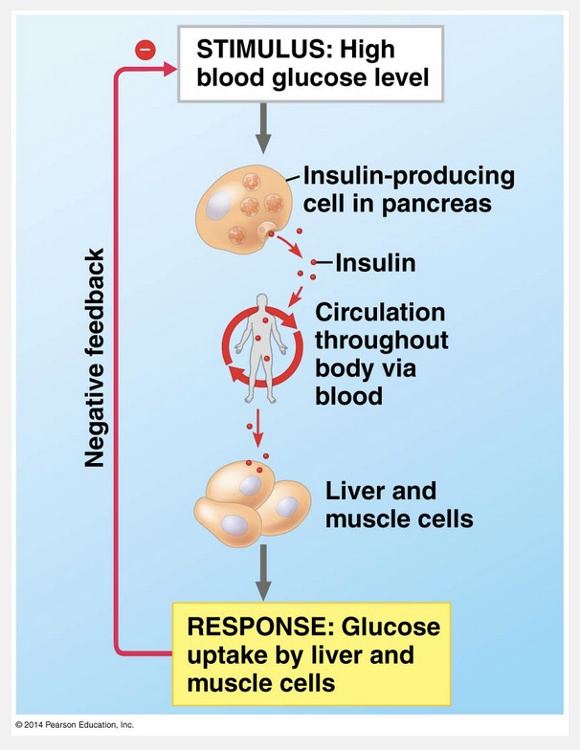
both negative feedback where the pathway shuts down and positive feedback where the pathway speeds up
Ex.
Feedback regulation includes both negative feedback where the pathway shuts down and positive feedback where the pathway speeds up.
In feedback regulation, the output, or product, of a process regulates that very process. The most common form of regulation in living systems is negative feedback, a loop in which the response reduces the initial stimulus. As seen in the example of insulin signaling, the uptake of glucose by cells (the response) decreases blood glucose levels, eliminating the stimulus for insulin secretion and thereby shutting off the pathway. Thus, the output of the process negatively regulates that process.
Though less common than processes regulated by negative feedback, there are also many biological processes regulated by positive feedback, in which an end product speeds up its own production. The clotting of your blood in response to injury is an example. When a blood vessel is damaged, structures in the blood called platelets begin to aggregate at the site. Positive feedback occurs as chemicals released by the platelets attract more platelets. The platelet pileup then initiates a complex process that seals the wound with a clot.
“Negative feedback where the pathway does not change” and “negative feedback where the pathway speeds up” are incorrect because in negative-feedback regulation, the pathway shuts down because there is a reduction in the initial stimulus. “Positive feedback where the pathway shuts down” and “positive feedback where the pathway does not change” are incorrect because in positive-feedback regulation, the end product speeds up its own production.
Some properties and processes that are associated with life include all of the following except _____________.
- growth and development
- order
- energy
- reproduction
- reductionism
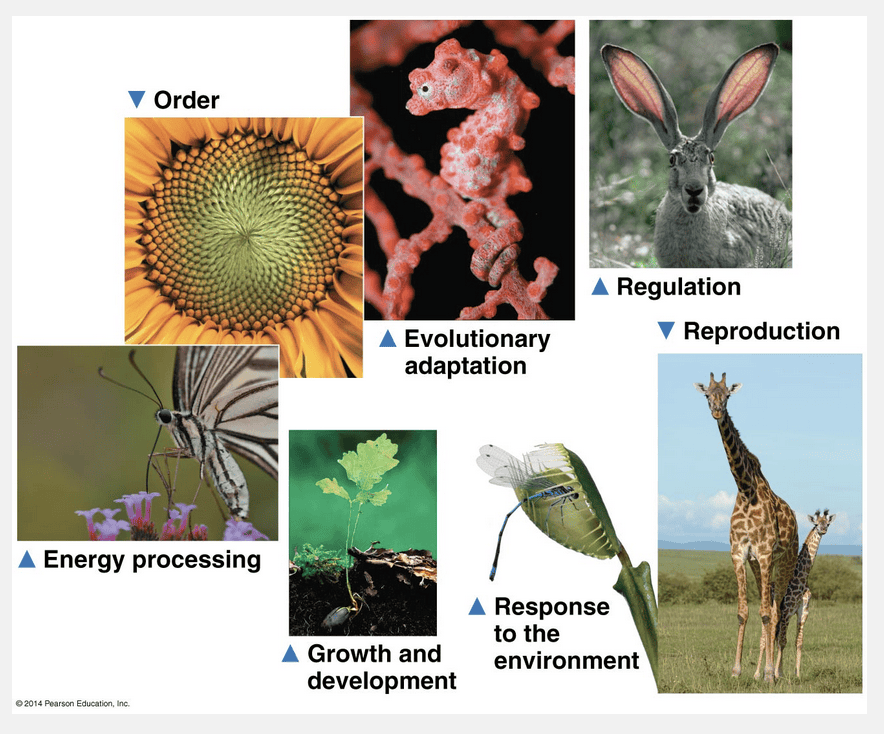
reductionism
Ex.
Some properties and processes that are associated with life include all of the following except reductionism.
Reductionism is a strategy for studying life which reduces complex systems to simpler components that are more manageable. It is not a property or process associated with life itself.
“Growth and development,” “reproduction,” “order,” and “energy” are some of the properties of life. Since this is an except question, these are all incorrect choices.
A nonlinear, realistic model of the scientific process is called the process of science. The core activity of this process is __________.
- exploration and discovery
- community analysis and feedback
- societal benefits and outcomes
- forming and testing hypotheses
- that there is no core activity since the process of science is linear
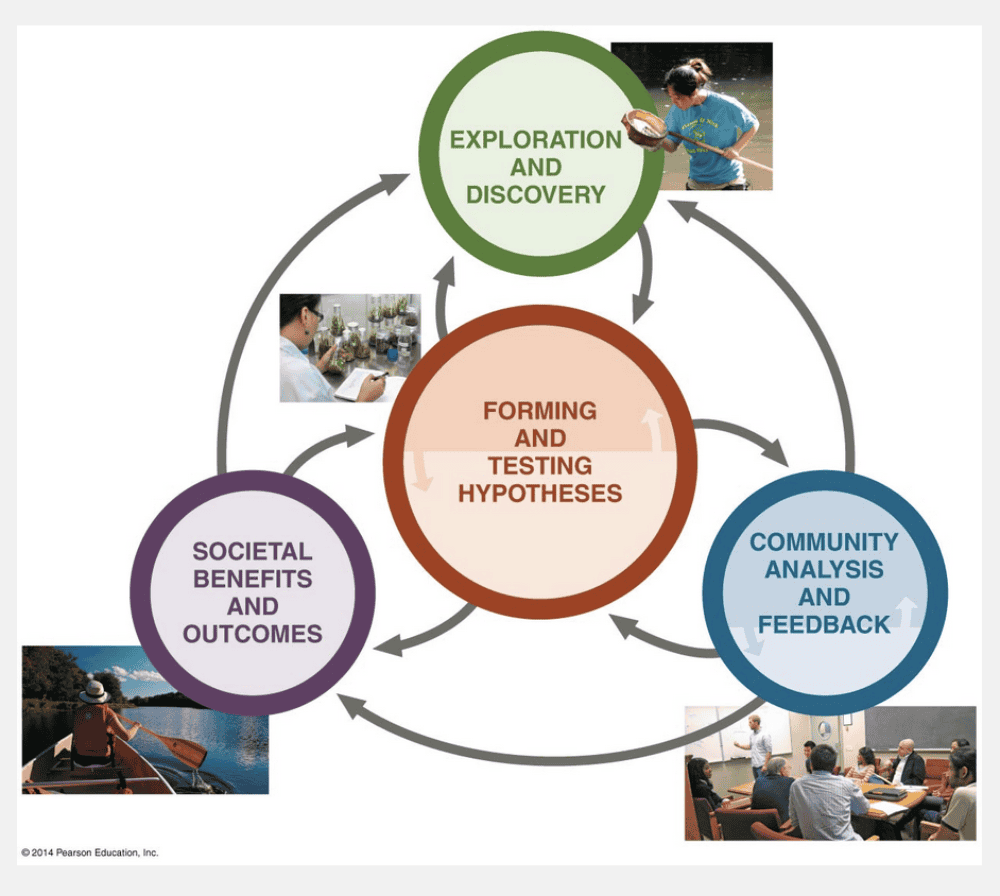
forming and testing hypotheses
Ex.
A nonlinear, realistic model of the scientific process is called the process of science. The core activity of this process is forming and testing hypotheses.
A more realistic model of the scientific process is shown in the figure here. The core activity (the central circle in the figure) is the forming and testing of hypotheses. This is the most fundamental aspect of science and is the reason that science does such a reliable job of explaining phenomena in the natural world. However, there is much more to the scientific process than just testing. The choice of ideas to test, the interpretation and evaluation of results, and the decision about which ideas to pursue for further study are influenced by three other arenas as well.
“Community analysis and feedback,” “exploration and discovery,” and “societal benefits and outcomes” are incorrect because the core activity is the forming and testing of hypotheses. “That there is no core activity since the process of science is linear” is incorrect because the process of science is a circular model involving backtracking, repetitions, and interactions of different parts of the process.
The energy used by most organisms for metabolism and growth ultimately comes from __________.
- sugars
- heat
- the sun
- decomposition of plants and other organic debris
- carbon dioxide
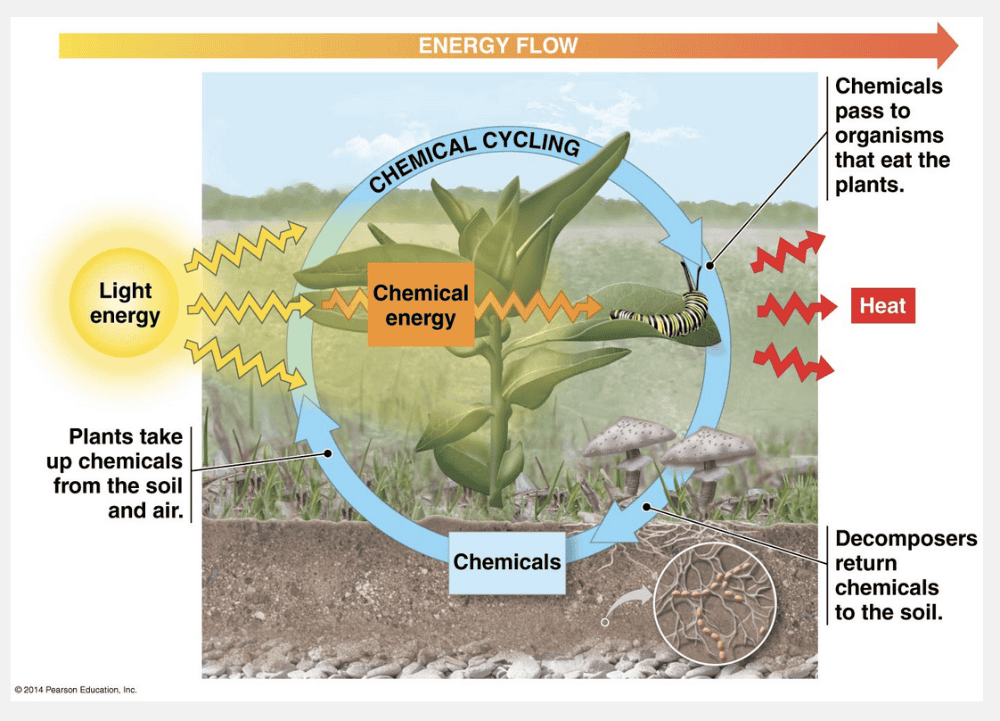
the sun
Ex.
The energy used by most organisms for metabolism and growth ultimately comes from the sun.
The sun provides light energy that certain organisms, called producers, capture during photosynthesis to combine carbon dioxide and water into sugar (chemical energy) for food. In turn, this sugar is passed along food chains as the producers are eaten by consumers, consumers are eaten by other consumers, and so on.
It is incorrect to say that heat, the decomposition of plants and other organic debris, carbon dioxide, or sugars account for the energy used by most organisms for metabolism and growth. Heat is lost to surroundings during most energy transformations, including photosynthesis, but heat is not the source of energy ultimately used by most organisms. The decomposition of plants and other organic debris results in nutrient recycling, but it is not the source of energy used by most organisms. Finally, carbon dioxide is the source of the carbon in sugars produced as a result of photosynthesis.
With evolution as the core theme of biology, we can explain traits shared by organisms as evidence of __________ and traits that differ among organisms as evidence of __________.
- systems biology; reductionism
- qualitative data; quantitative data
- coincidence; adaptation
- descent from a common ancestor; chance
- descent from a common ancestor; adaptation through natural selection
descent from a common ancestor; adaptation through natural selection
Ex.
With evolution as the core theme of biology, we can explain traits shared by organisms as evidence of descent from a common ancestor and traits that differ among organisms as evidence of adaptation through natural selection.
It is not correct to say that chance leads to differences among traits, because although chance can be a factor, natural selection is usually the driving force.
Shared traits may result from a shared common ancestor or convergent evolution (the evolution of similar features in independent evolutionary lineages due to similar environmental pressures), but coincidence is usually not a factor in determining shared traits.
Finally, systems biology and reductionism are ways of approaching biological problems, not explanations of organismal traits, so this answer is incorrect.
Which series of terms is in the correct sequence of biological organization, from the simplest to the most complex?
- Organism, ecosystem, community, population, biosphere
- Molecule, tissue, cell, organelle, organ
- Tissue, organ system, organ, cell, organism
- Cell, tissue, organ, population, community
- Community, population, ecosystem, habitat, biosphere
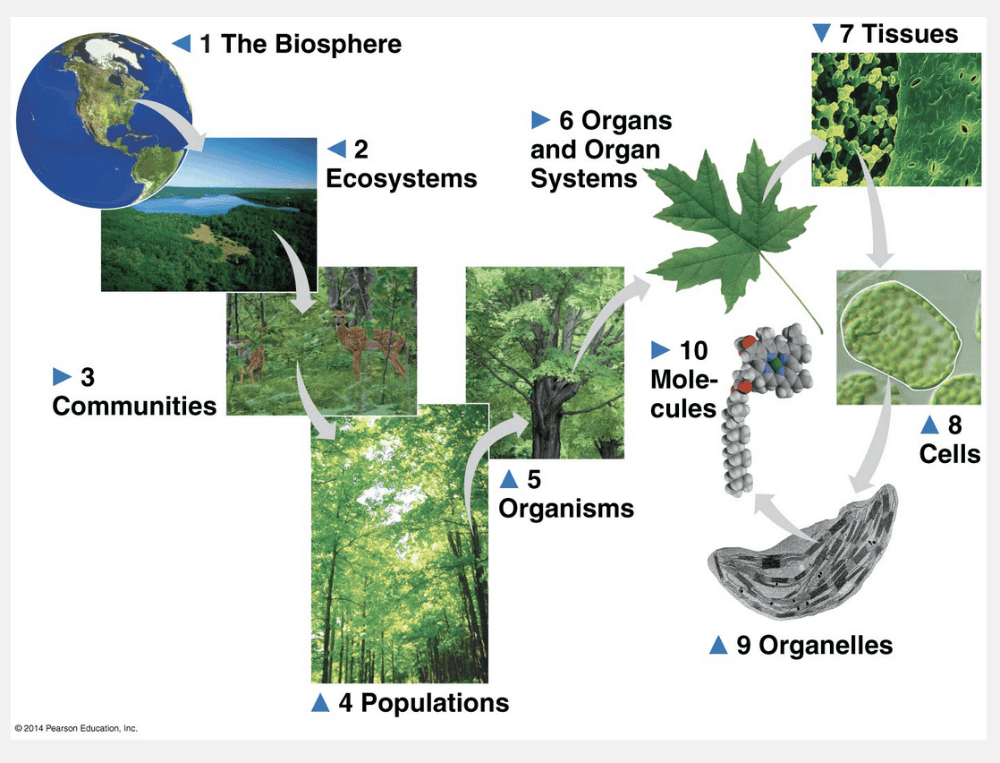
Cell, tissue, organ, population, community
Ex.
In order of increasing complexity, the correct terms are cell, tissue, organ, population, community.
The other answer choices are incorrect because the respective terms contained in each answer choice are not listed in order of increasing complexity.
Natural selection tends to act at which of the following levels?
- Phylum
- Kingdom
- Population
- Class
- Species
Population
Ex.
Natural selection tends to act on the population level.
This is because the natural environment “selects” for the propagation of certain traits among naturally occurring variant traits in a population of organisms.
It is incorrect to say that species, phylum, kingdom, or class is acted upon by natural selection. Populations of organisms of the same species that live in different environments experience natural selection differently because not all traits are suited for all environments. New kingdoms, phyla, and classes could result from evolution of species over time, but natural selection acts on a more simple level.
The concept of “descent with modification” was proposed by __________.
- Charles Darwin
- Hopi Hoekstra
- Watson and Crick
- None of the listed responses is correct.
- Jane Goodall
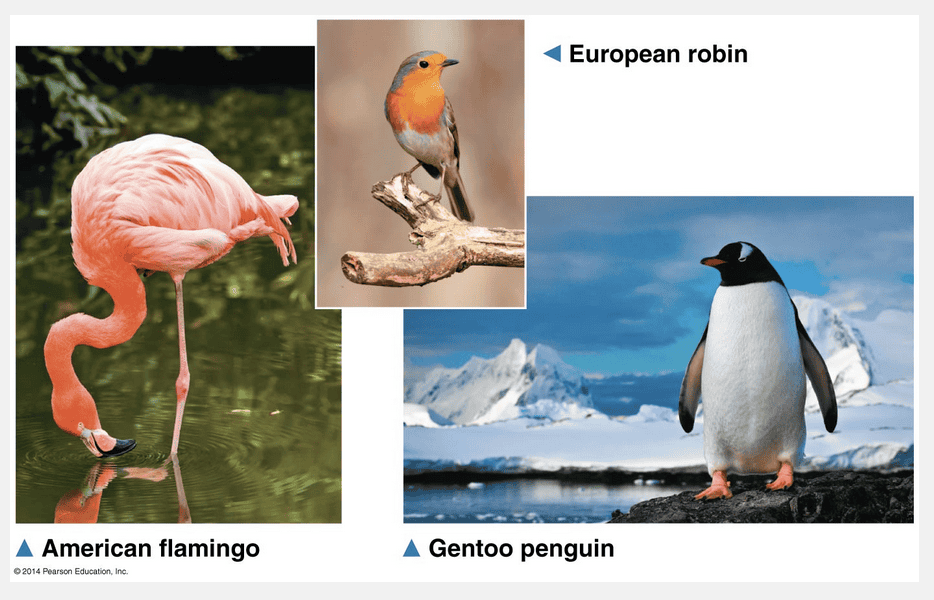
Charles Darwin
Ex.
The concept of “descent with modification” was proposed by Charles Darwin.
The history of life, as documented by fossils and other evidence, is the saga of a changing Earth billions of years old, inhabited by an evolving cast of living forms. This evolutionary view of life came into sharp focus in November 1859, when Charles Robert Darwin published one of the most important and influential books ever written. Entitled On the Origin of Species by Means of Natural Selection, Darwin’s book was an immediate bestseller and soon made “Darwinism,” as it was dubbed at the time, almost synonymous with the concept of evolution.
Th e Origin of Species articulated two main points. The first point was that contemporary species arose from a succession of ancestors that differed from them. Darwin called this process “descent with modification.” This insightful phrase captured the duality of life’s unity and diversity—unity in the kinship among species that descended from common ancestors and diversity in the modifications that evolved as species branched from their common ancestors.
“Watson and Crick” is incorrect because they came up with the double helix model for the structure of DNA.
“Jane Goodall” is incorrect because she collected qualitative data on chimpanzee behavior in a Tanzanian jungle.
“Hopi Hoekstra” is incorrect because she tested the hypothesis that coloration of beach and inland mice provides camouflage that protects them from predation.
The units of inheritance are called __________.
- proteins
- the double helix
- membranes
- genes
- chromosomes
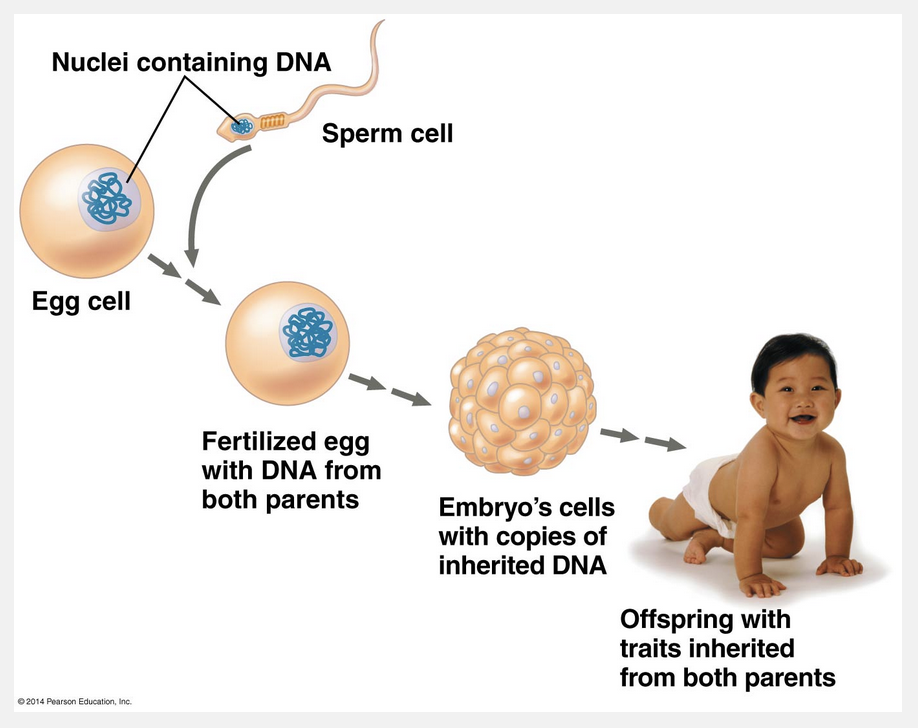
genes
Ex.
The units of inheritance are called genes.
Each chromosome contains one very long DNA molecule with hundreds or thousands of genes, each a section of the DNA of the chromosome. Transmitted from parents to offspring, genes are the units of inheritance. They encode the information necessary to build all of the molecules synthesized within a cell, which in turn establish that cell’s identity and function. Each of us began as a single cell stocked with DNA inherited from our parents. The replication of that DNA during each round of cell division transmitted copies of the DNA to what eventually became the trillions of cells of our body.
“Chromosomes” is incorrect because each chromosome contains one very long DNA molecule with hundreds or thousands of genes.
“Proteins” is incorrect because proteins are not genetic material but products of gene expression.
“Membranes” is incorrect because membranes enclose all cells and regulate the passage of materials between the cell and its surroundings.
“The double helix” is incorrect because the double helix is the molecular structure of DNA.
A scientific theory is __________.
- not correct unless it is several years old
- a poorly supported idea that has little backing but might be correct
- a well-supported concept that has broad explanatory power
- the same thing as a hypothesis
- a concept that, once established in the scientific literature, can be modified but never rejected, even when new scientific methods produce data that don't fit
a well-supported concept that has broad explanatory power
Ex.
A scientific theory is a well-supported concept that has broad explanatory power. Theories are comprehensive and become widely accepted if large bodies of evidence support them.
It is not correct to say that a theory is a poorly supported idea that has little backing but might be correct; theories are well supported by experimental evidence.
It is incorrect to say that a theory is the same as a hypothesis; a hypothesis is much narrower in scope than a theory.
It is incorrect to say that theories are not correct unless they are several years old; if enough evidence supports the theory, then it does not matter how old the theory is for it to be valid.
Finally, it is incorrect to say that a theory is a concept that, once established in the scientific literature, can be modified but never rejected, even when new scientific methods produce data that don’t fit. Data that might not fit a current theory could be generated due to technological advances. It wouldn’t be wise to stick with an incorrect theory simply due to precedent, when new data could require further evaluation of the theory’s correctness.
Which of the following is an attribute of living things?
- They must be able to evolve and adapt.
- They must be dependent on oxygen.
- They must be carbon-based.
- They must be able to reproduce sexually.
- All of the listed responses are correct.
They must be able to evolve and adapt.
Ex.
The following is an attribute of living things: they must be able to evolve and adapt. The ability to evolve and adapt is the fundamental organizing principle of biology.
It is not correct to say that life-forms must be carbon-based, because although organisms on Earth are carbon-based, there is no reason they couldn’t be based on some other element.
Since many organisms are anaerobic, or live in the absence of oxygen, it is not correct to say that life is dependent on oxygen.
Because many organisms reproduce asexually, it is not correct to say sexual reproduction is required for life.
The process that directs the manufacture of a cell product from a gene is called __________.
- gene expression
- genomics
- bioinformatics
- systems biology
- proteomics
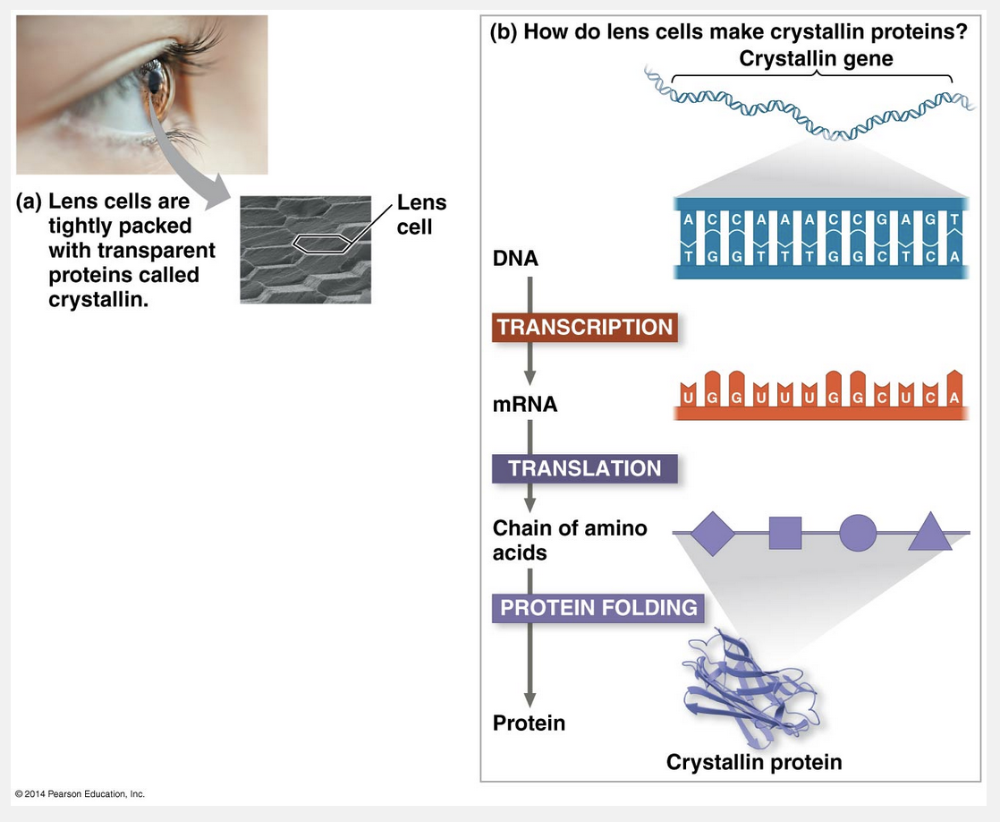
gene expression
Ex.
The process that directs the manufacture of a cell product from a gene is called gene expression.
Genes control protein production indirectly, using a related molecule called RNA as an intermediary. The sequence of nucleotides along a gene is transcribed into RNA, which is then translated into a linked series of protein building blocks called amino acids. These two stages result in a specific protein with a unique shape and function. The entire process, by which the information in a gene directs the manufacture of a cellular product, is called gene expression.
“Genomics” is incorrect because it involves the study of whole sets of genes in one or more species.
“Proteomics” is incorrect because it involves the study of sets of proteins and their products.
“Bioinformatics” is incorrect because it is an approach that makes use of computational tools to store, organize, and analyze data that result from high-throughput technology used in genomic and proteomic research.
“Systems biology” is incorrect because it is the exploration of a biological system by analyzing the interaction among its parts.
The use of energy and matter by living organisms __________.
- involves chemical cycling from light energy from the sun for the production of chemical energy in food to the decomposition and the returning of chemicals to the cycle
- is a noncyclic process
- involves chemical cycling from chemical energy in food to light energy from the sun to heat lost from the ecosystem
- includes only the consumers in the ecosystem
- never leads to the loss of heat from the ecosystem
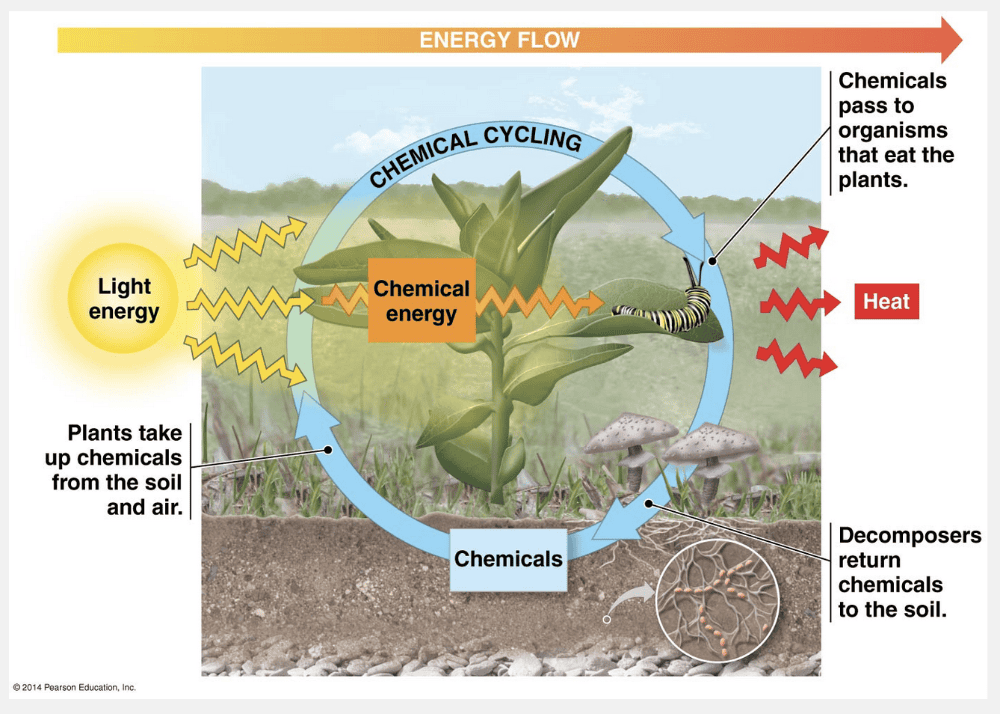
involves chemical cycling from light energy from the sun for the production of chemical energy in food to the decomposition and the returning of chemicals to the cycle
Ex.
The use of energy and matter by living organisms involves chemical cycling from light energy from the sun for the production of chemical energy in food to the decomposition and the returning of chemicals to the cycle.
A fundamental characteristic of living organisms is their use of energy to carry out life’s activities. Moving, growing, reproducing, and the various cellular activities of life are work, and work requires energy. The input of energy, primarily from the sun, and the transformation of energy from one form to another make life possible. A plant’s leaves absorb sunlight, and molecules within the leaves convert the energy of sunlight to the chemical energy of food, such as sugars, produced during photosynthesis. The chemical energy in the food molecules is then passed along by plants and other photosynthetic organisms (producers) to consumers. Consumers are organisms, such as animals, that feed on producers and other consumers. When an organism uses chemical energy to perform work, such as muscle contraction or cell division, some of that energy is lost to the surroundings as heat. As a result, energy flows one way through an ecosystem, usually entering as light and exiting as heat. In contrast, chemicals are recycled within an ecosystem. Chemicals that a plant absorbs from the air or soil may be incorporated into the plant’s body and then passed to an animal that eats the plant. Eventually, these chemicals will be returned to the environment by decomposers, such as bacteria and fungi, that break down waste products, leaf litter, and the bodies of dead organisms. The chemicals are then available to be taken up by plants again, thereby completing the cycle.
“Involves chemical cycling from chemical energy in food to light energy from the sun to heat lost from the ecosystem” is incorrect because chemical cycling is an energy flow from light energy from the sun for the production of chemical energy in food to the decomposition and the returning of chemicals to the cycle.
“Is a noncyclic process” is incorrect because the use of energy by living organisms involves chemical cycling, which is a cyclic process.
“Never leads to the loss of heat from the ecosystem” is incorrect because in chemical cycling, heat is always lost from the ecosystem.
“Includes only the consumers in the ecosystem” is incorrect because the use of energy by living organisms requires that plants, the photosynthetic producers, convert light energy from the sun to the chemical energy of food.
What is the molecule that can account for both the unity and the diversity of life?
- Mutation
- DNA
- Protein
- Ribosomes
- Lipids
DNA
Ex.
The molecule that accounts for both the unity and diversity of life is DNA.
The uniformity of coding in DNA is virtually universal. Life’s variety arises from variations in the nucleotide sequences of inherited DNA molecules, the substance of genes. It is not correct to say that proteins, lipids, ribosomes, or mutations are the molecules that account for both the diversity and the uniformity of life.
DNA provides the blueprints for making proteins, and proteins are the main players in building and maintaining the cell and carrying out its activities.
Lipids are a class of molecules that includes fats.
Ribosomes play a role in protein synthesis within a cell.
Mutations are changes in the sequence of an organism’s genetic code, and can result in harmful (or in some cases, beneficial) consequences for an organism.
Regulation of molecules within an organism in response to a changing level of chemicals and the ability to self-regulate is called __________.
- gene expression
- energy flow
- adaptation
- feedback regulation
- natural selection
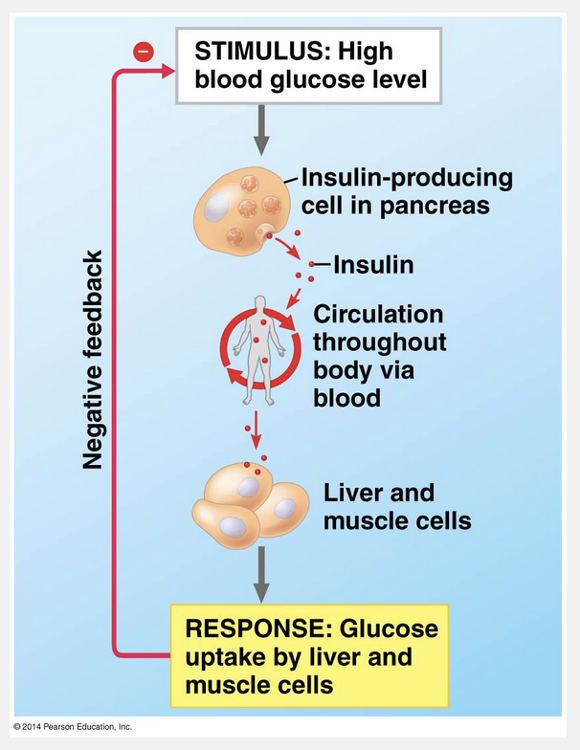
feedback regulation
Ex.
Regulation of molecules within an organism in response to a changing level of chemicals and the ability to self-regulate is called feedback regulation.
At lower levels of organization, the interactions among components that make up living organisms—organs, tissues, cells, and molecules—are crucial to those components’ smooth operations. Consider the sugar in your blood, for instance. After a meal, the level of the sugar glucose in your blood rises.
The increase in blood glucose stimulates the pancreas to release insulin into the blood. Once it reaches liver or muscle cells, insulin causes excess glucose to be stored in the form of a very large carbohydrate called glycogen, which reduces the blood glucose level to a range that is optimal for bodily functioning. The lower blood glucose level that results no longer stimulates insulin secretion by pancreas cells. Some sugar is also used by cells for energy: When you exercise, your muscle cells increase their consumption of sugar molecules. Interactions among the body’s molecules are responsible for most of the steps in this process. For instance, like most chemical activities in a cell, those that either decompose or store sugar are accelerated at the molecular level (catalyzed) by proteins called enzymes. Each type of enzyme catalyzes a specific chemical reaction. In many cases, these reactions are linked to chemical pathways, each step with its own enzyme. The key is the ability of many biological processes to self-regulate by a mechanism called feedback. Feedback is a regulatory motif common to life at all levels, from the molecular level through ecosystems and the biosphere level. Interactions among organisms can affect system-wide processes like the growth of a population.
“Energy flow” is incorrect because it involves the one-way flow of energy in an ecosystem.
“Gene expression” is incorrect because this is the process by which the information in a gene directs the manufacture of a cellular product.
“Adaptation” is incorrect because it is part of the theme of evolution as proposed by Darwin.
“Natural selection” is incorrect because this was proposed by Darwin as an evolutionary mechanism for descent with modification.
Which of the following statements is most clearly inductively derived?
- A paramecium moves by means of the rhythmic motion of its cilia.
- An elephant is warm-blooded because it is a mammal.
- Because worms lack bones, they are classified as invertebrates.
- If all flying animals are birds, then it can be concluded that bats are birds.
- If the animals observed require organic molecules as nutrients, then it can be concluded that all animals require organic molecules as nutrients.
If the animals observed require organic molecules as nutrients, then it can be concluded that all animals require organic molecules as nutrients.
Ex.
The statement “If the animals observed require organic molecules as nutrients, then it can be concluded that all animals require organic molecules as nutrients” is inductively derived. By definition, induction moves from a set of specific observations to reach a general conclusion.
None of the other answer choices fit this definition; thus, they are incorrect.
Which of the following statements best describes what is meant by "emergence"?
- Emergence is due to the decreased complexity of biological and chemical systems when considered from a "reductionist" perspective.
- Only life displays emergence.
- Emergence is best observed only at the microscopic level of biology or the atomic level of chemistry.
- The whole is greater than the sum of the parts.
- The sum of the parts is greater than the whole.
The whole is greater than the sum of the parts.
Ex.
The statement “The whole is greater than the sum of the parts” describes emergence.
Emergence refers to novel properties of a living system that result from the arrangement and interactions of specific parts of the living system as complexity within the system increases.
Thus, it would be incorrect to describe “emergence” with any of the other answer choices.
Which of the following is the smallest unit of organization that can perform all activities required for life?
- Organism
- Organelle
- Cell
- Tissue
- Organ
Cell
Ex.
The cell is the smallest unit of organization that can perform all activities required for life
Some organisms, such as bacteria, are single cells. Others, including plants and animals, are multicellular. Instead of performing all activities required for life, a multicellular organism has a division of labor among specialized cells.
Organelles are various functional components, such as chloroplasts, that are present in cells.
Tissues are composed of many cells of similar structure and function.
Organs consist of two or more tissues that work together to perform a particular function.
Finally, organisms are individual living things; some are composed of a single cell, but many are not.
The fundamental organizing principle of biology and core theme is __________.
- energy
- evolution
- order
- growth and development
- reproduction
evolution
Ex.
The fundamental organizing principle of biology and core theme is evolution.
Evolution is the process of change that has transformed life on Earth from its earliest beginnings to the diversity of organisms living today. Because evolution is the fundamental organizing principle of biology, it is the core theme of this book.
“Growth and development,” “reproduction,” “order,” and “energy” are all incorrect answers because they are some of the properties of life.
The three domains of life __________.
- are bacteria, archaea, and animalia
- are bacteria, protists, and animalia
- is an incorrect statement because there are only two domains of life
- are bacteria, archaea, and eukarya
- are animalia, plantae, and fungi
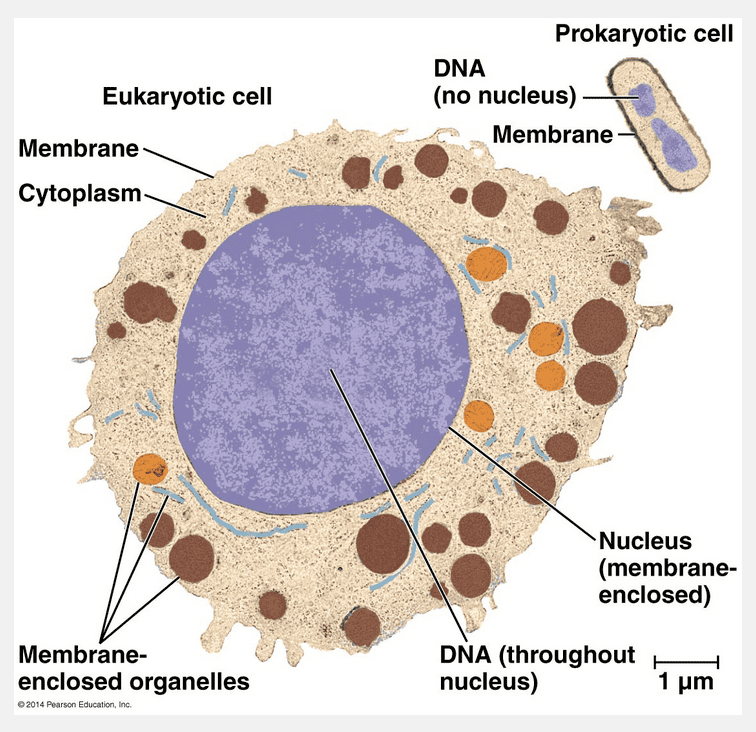
are bacteria, archaea, and eukarya
Ex.
The three domains of life are bacteria, archaea, and eukarya.
Historically, scientists have classified the diversity of life-forms into species and broader groupings by careful comparisons of structure, function, and other obvious features. In the last few decades, new methods of assessing species relationships, such as comparisons of DNA sequences, have led to an ongoing reevaluation of the number and boundaries of kingdoms. Researchers have proposed anywhere from six to dozens of kingdoms. While debate continues at the kingdom level, biologists agree that the kingdoms of life can be grouped into three even higher levels of classification called domains. The three domains are named bacteria, archaea, and eukarya. The bacteria and archaea are prokaryotic. All the eukaryotes (organisms with eukaryotic cells) are now grouped in domain eukarya. This domain includes three kingdoms of multicellular eukaryotes: kingdoms plantae, fungi, and animalia. These three kingdoms are distinguished partly by their modes of nutrition. Plants produce their own sugars and other food molecules by photosynthesis, fungi absorb dissolved nutrients from their surroundings, and animals obtain food by eating and digesting other organisms. Animalia is, of course, the kingdom to which we belong. But neither plants nor fungi nor animals are as numerous or diverse as the single-celled eukaryotes we call protists. Although protists were once placed in a single kingdom, recent evidence shows that some protists are more closely related to plants, animals, or fungi than they are to other protists. Thus, the recent taxonomic trend has been to split the protists into several kingdoms.
“Are animalia, plantae, and fungi” is incorrect because these are examples of kingdoms in the domain Eukarya. “Are bacteria, archaea, and animalia” is incorrect because animalia is a kingdom of multicellular eukaryotes that ingest other organisms. “Are bacteria, protists, and animalia” is incorrect because protists are mostly unicellular eukaryotes and animalia is a kingdom of multicellular eukaryotes that ingest other organisms. “Is an incorrect statement because there are only two domains of life” is incorrect because there three domains of life.
What is the appropriate term for an interacting group of individuals of a single type occupying a defined area?
- Species
- Ecosystem
- Habitat
- Population
- Community
Population
Ex.
Population is the term for an interacting group of individuals of a single type occupying a defined area. “Population” is the general term that describes a group of individuals of a single type occupying the same area.
“Species” is incorrect because this term describes a population whose members have the potential to interbreed and produce viable offspring in nature. Members of a species may be geographically isolated and unable to interact with one another.
“Ecosystem” is incorrect because this term describes all of the populations of organisms in a given area as well as the abiotic, or nonliving, components of the environment.
“Community” is incorrect because this term describes all of the populations of species in a given area.
“Habitat” is also incorrect; this term describes an ecological niche inhabited by members of a population.